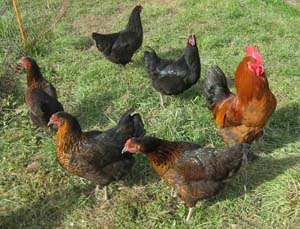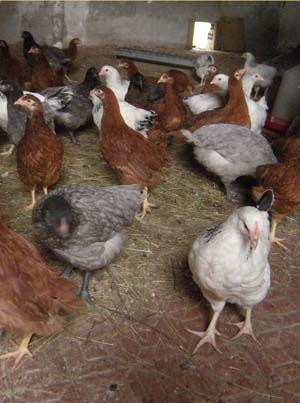
|
Hens for Sale in Haut Garonne
|

|
| www.izaut-rustica.com | In sympathy with nature and respectful to the environment |
french version 
|

|
Hens for Sale in Haut Garonne
|

|
| www.izaut-rustica.com | In sympathy with nature and respectful to the environment |
french version 
|
| Poulettes en vente 2021: | ||||
|---|---|---|---|---|
| Race / hybride | Status | Age | Quantité | Tarif |
| Isle de Noire / Rousse | poussins | 2 mois (mi-Mai) | 25/25 | 9 Euros |
| Isle de Noire / Rousse | PRE == pré-production | 3 mois (mi-Juin) | 25/25 | 12 Euros |
| Isle de Noire / Rousse | PAP == prêt-à-pondre | 4 mois (mi-Juillet) | 25/25 | 15 Euros |
| Isle de Noire / Rousse | COM == commerciale | 5 mois (mi-Août) | 25/25 | 18 Euros |
Status of young hensThe status of our young hens is given as follows:PRE at 3 months old a hen is 'pre-production' - she is too young to lay at all POL at 4 months old a hen is 'point of lay' - she is ready to lay; 50% of the group will have begun to lay, egg size will be small - weight as low as 30g COM at 5 months old a hen is 'commercial' - the eggs now have a commercial value; 90% of the group will be laying with 50% of the eggs size medium - weight around 50g NB at 6 months old all of the group will be laying with 90% of the eggs size medium - weight around 50g |
The characteristics of egg-laying hens: Varieties and HybridsFirstly, we purchase chicks named "Noir de l'Isle" (after the town - L'Isle Jourdain). They result from the crossing of two breeds which are good egg-layers. They are equivalent to "Harco" - a crossing of "Rhode Island" and of "Plymouth Rock". From time to time, other varieties are available; they are named by the suppliers but their characteristiques are broadly known and comparable everywhere. According to the choice, a hen will vary in the following repects:
|
 |
Our businessWe have raised and kept hens now for 11 years; our principal interest is in egg production. In order to comply with organic certification, we buy day-old chicks (typically in batches of 100) and raise them under organic rules. This includes giving them ample space indoor and outdoor and feeding them organically sourced grain and other supplement. We always buy and raise more than we need for our own egg production, and in this manner some are available for sale at point-of-lay.In order to keep up the egg production we are always renewing our flocks, typically after 2yrs of laying. These older hens are often sold for the table, but some people are content to acquire these mature hens for laying at a slower rate. Contact Lee for more details: 05 61 94 64 77 - lunchtime or evenings To locate us please consult maps on our Home page - click here: Home |
 |
Henrietta's flockSometimes we also have chicks hatch here on our premises; this can be 'au-naturel' - with the warmth of a broody hen, otherwise with the use of an incubator. We allow or program these hatchings to assist with school visits. The hens which grow from these hatchings are less controlled in characteristic - but can nevertheless be good layers. Cockerels inevitably arise from these broods and may also be available for sale - to keep with a familial flock or for the table. |
 |
Sketch of a hen's lifeIf a chick survives the first 3 days of its life it will grow rapidly in size and mobility. Point of lay may be as early as 4 months but usually at 5 months age. At this point the eggs will be small (a size never seen in the shops). Laying will nevertheless be frequent, and after 6 months egg size may be considered normal/medium.Given the right conditions a hen will continue to lay eggs for many years but with the trend of larger eggs less frequently. The right environmantal conditions include space and hygiene, while correct nutrition includes essential proteine and minerals. It is normal commercial practice to retire a hen from laying after as little as 1 year (ie. 18months old). We begin to retire our hens after 2 years; at this time, quality of laying within a group will be less predictable. Egg production without human management is normally seasonal as it depends on daylength - in turn determined by available light. We do at times use a light source to extend daylength but for the most part find this unnecessary. When shorter winter days arrive a hen may quit laying and enter a moult; this can be slight or deep with consequent loss of production. |
 |
Backyard hensThe majority of hens sold are sold in small groups - quite often 2 at a time for a family - backyard. Backyard hens are frequently victim to predator attacks by fox, badger, marten or stray dog. However if given the correct security, keeping hens at home can pay for itself and create interest for the family. To help you with planning here are some guidelines to work to:Requirements for keeping hens:Perch space: 18cm / birdIndoor floor space: 6 hens / m2 Outdoor ground space: 1 hen / 4m2 (according to organic rules) Food ration 130g / adult bird / day |
 |